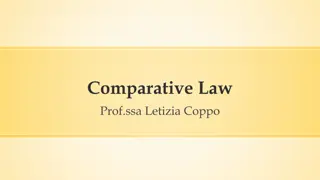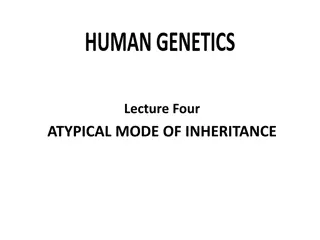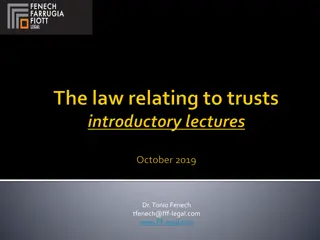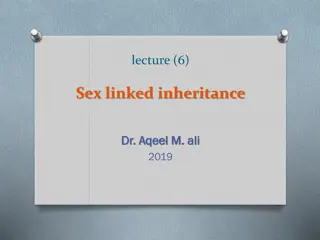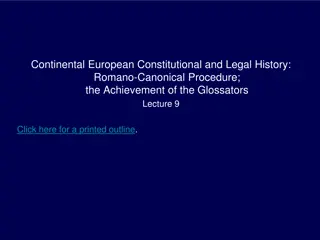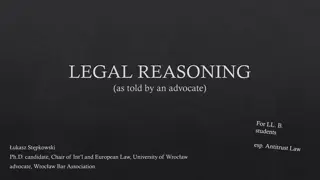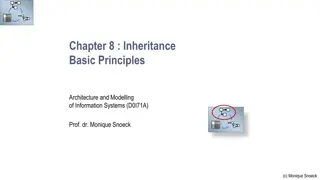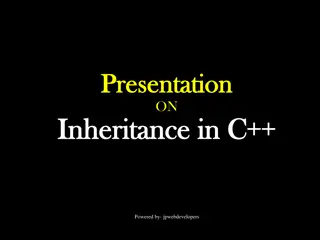Evolution of Inheritance Law in European Legal History
Inheritance law, also known as succession, plays a significant role in the devolution of property to heirs upon the owner's death. The evolution of Roman Inheritance Law during the imperial period, competition between civil and pretorian law systems, and the process of succession are explored in detail. Key aspects such as appointment to inheritance, succession, and the importance of maintaining property regime are highlighted.
Download Presentation

Please find below an Image/Link to download the presentation.
The content on the website is provided AS IS for your information and personal use only. It may not be sold, licensed, or shared on other websites without obtaining consent from the author. Download presentation by click this link. If you encounter any issues during the download, it is possible that the publisher has removed the file from their server.
E N D
Presentation Transcript
European Legal History: Inheritance Law
Inheritance law Inheritance, also called succession,the devolution of property on an heir or heirs upon the death of the owner. The term inheritance also designates the property itself. In modern society the process is regulated in minute detail by law. In the civil law of the continental European pattern, the pertinent branch is generally called the law of succession. In Anglo-American common law it was customary to distinguish between descent of real estate and distribution of personal estate. The rules applicable to the two kinds of property have been fused, but no common, overall name accepted. is yet universally
Specifics of Roman Inheritance law Significant development during imperial period Competition of two systems: civil and pretorian law Remarkable evolutions from agnatic to cognatic succession system Subject of keen interest among lawyers almost of Iustinian s codifications contains regulations about inheritance law Large number of responsa that contains answers to questions about inheritance law suggest, that this particular branch of law was living subject of everyday law practice Main goal of inheritance law was to maintain existing property regime and at the same time ensure broad ability to transfer property mortis causa
Succesion Succession takes effect in a result of the death of a person which had the ability to transfer his possessions. The possibility of inheritance is called an appointment to inheritance (delatio hereditatis). While the closest heirs (called domestic heirs) mere appointment was sufficient to become an heir. External heirs needed additional act of acquisition of estate. In classic law the formal act of cretio was required, in later times even informal acquisition (for example in a way of executing the legacies) sufficed
Appointment to inheritance may be the result of: will of the deceased expressed in the form of a testament (testate succession) in case of lack of testament or situation that testament was defective where where the case of statutory succession or intestate succession, In case that domestic heirs wasn t disinherited and didn t get anything from the will to protect closest family members there was a case of contra testate succession
Residuary estate (hereditas) An estate - the non-material things (one of the first and most important). It included both material things and the rights, but with its acquisition involved responsibility for the debts of the previous owner. Its acquisition led to general succession (as opposed to the singular Succession didn t involved rights and obligations of a personal nature. Position in family hereditary. succession) wasn t as well Relatively easier to acquier ownership via prescription (no good faith requirement and shorter amount of time required)
Principles of Roman inheritance law I. Heres in poenam non succedit. II. Nemo pro parte intestatus decedere potest III. Semel heres, semper heres IV.Testamentary freedom (causa Curiana verba or voluntas) V. Nasciturus pro iam habetur, quotiens de commodis eius agitur. testatus, pro parte
Two systems of succession Basic successions was regulated in civil law by the Law of Twelve Tables and survived until Justinian s legislation. Formalism and narrow scope led to creation of competitive system of pretorian succession bonorum possessio. Both systems survived until Novel 118 and 127 led to creation of postclassical law. system of testate and intestate singular system in
Bonorum possessio bonorum started possession of the persons for the time of succession trial the person most likely to become an heir (supporting civil law). Possessio as a way initiate estate property for a class of Praetor also began to give possession of the property to the ius civile heirs, who for some reason lost theirs title or to person outside of the circle, which was considered rightly legitimized (completing civil law). Over time, in order to reduce the anachronistic intestate succession laws of inheritance praetor admitted possession to certain individuals against civil heirs for example to emancipated son before his uncle (correcting civil law).
Testate succession Made through a will Freedom of dividing of property testator could freely change testament or create new one Immorality of inheritance agreements Testate succession succession statutory heirs inherit estate only in case of absence testamentary heirs or cancel previous precede statutory or waiver made by
Capacity to create a testament It was the ability to create a will (qualified type of legal capacity). It was possessed by: -Roman citizens of sui iuris status, that wasn t limited to their ability to act (eg. due to their age) -Latins and peregrins with ius commercium -Persons on alieni iuris status in case of certain type of their personal estates (bona materna/peculium castrense) -- state slaves in case of half of the value of their peculium
Capacity to become a testamentary heir Ability to inherit an estate from testament was possessed even by: Slaves - liberated in will Nasciturus - unborn child, if it was born alive Churches, charities and associations in classical law
Type of wills in ius civile Testamentum calatis commitis (twice a year at a people assembly it was possible to declare will in front of pontifex maximus) Testamentum in procintu (declaration made in front of the army ready for battle- it was only availble for for the soldiers during the war) These mentions them only in the context of the past) forms fallen into disuse (Cicero
Testamentum per aes et libram - one of the forms of use of the abstract nature of the mancipatio. Testator during his lifetime made special sell of his estate to special confidant (familiae emptor) who was obliged to give the estate after testator death to designated heirs. Whole act required presence of 5 witnesses and libripens, who weight symbolic payment. classic law the second stage of act was created (nuncupatio) which allowed to designated heirs orally or in writing which reduced role of familae emptor to a special witness. In
Wills in pretorian law Due to a number of civil law formalities wills often proved to be invalid. Praetor announced that he will provide possessio bonorum to a person who will submit a testament wearing seals of seven witnesses. This type always written. of testament was
Wills in postclassical law Normal wills (private): a) Testementum tripertitum b) Testamentum per holographam scripturam Privileged forms: a) Testamentum pestis tempore conditium b) Testamentum miitis c) Testamentum ruri conditum Restrictive forms: a) Testament osoby g uchniemej b) Testament osoby niewidomej Public forms: a) Testmentum principi oblatum b) Testamentum apud acta conditum
Normal types of wills Prepared in form of single act (oral or written), in one place, in the same time. Testementum tripertitum - combined the principles of civil law (simultaneous presence), pretorian law (seals of 7 witnesses) and imperial law(signature of the testator and witnesses), introduced by Theodosius II in 439 AD Testamentum per holograph scripture - a testament personally written and signed by the testator, introduced Constitution Valentinian III in 466 AD
Priviledged types of wills principle is more comparison to normal forms. Examples: Their liberal form in * A will drawn up during the epidemic (not requiring the simultaneous witnesses) *Testament of a soldier - Emperor Trajan declared that any testament made by soldier - oral or written even without meeting all of the formal requirements had the legal effect. presence of
Restrictive forms of wills Characterized by requirements. the additional formal Examples: Testament of the blind (requiring signing by 7 witnesses and a local official - tabularius, in the absence of this second requirement signs of 8 witnesses Testament of deaf person such document could be made only personally by the testator was required)
Public forms of wills The participation of the public factor was required in these forms: Testament submissed (testamentum principi oblatum) Testament made to the protocol of judicial or municipal authorities testamentum conditum) to the Emperor (apud acta
Legal effects of will: invalidity and ineffectivness The nullum) will was invalid from the beginning because of: It didn t meet the formal requirements That the testator or the heir did not have the testamentary capacity Omission of a son under the authority invalidity of the will (testamentum
Ineffectiveness rumptum) - the invalidity is the result: of the will (testamentum Birth of a statutory heir in the will is not taken into account Capitis deminutio of the testator (with the exception of slavery as a result of military campagin - fictio Legis Corneliae ) In the case of rejection testamentary heirs of will by
Codicil It was not always possible to maintain the full requirements of the will in case of the content and form and cases dispositions mortis causa were put in ordinary letters. in some There was some limitations: it was not possible to establish an heir or make disinheritance via this kind of letter. Other dispositions can be maintained in force when the codicil was confirmed by the testament, and in the absence of confirmation only effective type of dispositions was fidei- commision/trusts. Codicillary clause allowed the maintenance of a will burdened with formal or material defects as a codicil.
Types of regulations in wills The establishment of an heir (general succession) Singular dispositions (legacies and trusts) Disinheritance of a statutory heir Substitution Other regulations such as the liberation of the slaves, the establishment of guardians for minors and women
Estabilishment of an heir Initially by the solemn and emphatic formula that needed to be first sentence of will: for example - Casius heres esto! Since the beginning of the fourth century every sentences that testator to estabilish certain person as an heir was sufficent. contained will of
Substitution (substitutio) The institution of the conditional appointment enabled by the testator to determine who will be the heir in case his heir did not want or could not acquire the estate, and in some cases allowed to indicate the heir heir. Types: common substitution (deceased invoked a number of substitutes for each other - ending substitution usually by estabilishing slave as an heir) Pupilary substitution - the heir, who was the person sui iuris and a child - in the event of his death before becoming an adult Quasi pupilary substition - Ascendant (father) could establish an heir for his descendent (son), who was mentally ill
Disinheritance Disinheritance was not a negative assessment of the heir but a specific instrument to regulate succesion in more freely manner- not including the statutory heirs in the will without disinheriting them could lead to the invalidity of the will of the formal reasons. Disinheritance was made: * In relation to the son by name * In relation to other sui heredes - also by using the general formula what allowed to disinherit them all at once Institution of unworthiness (indignitas) - the concept was born in imperial law and defined negative assessment of behavior of the heirs in relation to the deceased. This institution allowed to take estate from unworthy heir in favour of imperial treasury.
Legal effects of acquisition of estate I. General succession of the deceased ("fusion" of the estates of deceased and heir) II. Taking over the debts of the deceased (liability from personal estate) Acceptance with full liability (in the form indistinguishable from today's acceptance with the benefit of inventory), which could lead to a number of adverse effects of property. This led to two adjustments: Separatio bonorum - in the interests of creditors Beneficium inventarii - in the interests of heirs
Collocatio bonorum This institution allowed to take part in inheritance for the emancipated children if they add their estates to deceased estate. Examples of estates: *Dowry *Items that son had received from his father as a soldier or official * Received donations (unless the testator declared that they inheritance) will not added to
In ancient Rome, the inheritance of whole or fractional part of estate was associated with liability for the debts of deceased. On the other hand, it was possible to partially donate part of estate without liability for the debts. There were two variations of such partial decree: legacies and trusts.
Legacies: the only form of singular disposition known in ancient Roman law. The establishment of the legacy was carried out in a formal way with certain words, strictly defined by law Legacy burdened only testamentary heir, so it had to be placed in will.
Legacy per vindicationem Legatee become owner of the thing in Transfer ownership to legatee Heir has legal obligation to give object of legacy to legatee the moment of death of testator TESTATOR LEGATEE HEIR
Legacy per damnationem Claim to heir to receive ownership of a thing Obligation to give something to legatee Legatee Heir
Limitations of legacies Lex voconia (169 BC) no one can acquire by legacy more than an heir Lex falcidia (40 BC) legacies could be more than of the deceased estate after deducting of the debts , this of free from debts and legacies estate was inherited by heirs, legacies that exceed that limit were invalid L
Trusts- informal requests to make a donation of property to designated person issued by the testator to someone who received some benefit from the will Differences between trusts and legacies: Trusts does not necessarily have to be placed in a will could be oral or in codicil Trusts could burden not only heir but also legatee Trust didn t gave rise to legal obligation, it was only moral duty to complete them
Uniwersal trust Ordered trustee to give the whole estate to third person (beneficiary) Testator Trustee Beneficiary
Functions and importance of singular dispositions -can ensure the basic needs for disinherited family members and children born out of wedlock - could improved disadvantageous position of spouses -reward the services of friends - ensure future carrier of children by gifts to important persons
Three systems of statutory succession 1) Agnatic (Law of Twelve Tables) 2)Agnatic-cognatic (pretorian law) 3) Cognatic (Iustian s Novellae)
Agnatic system three degrees of proximity Sui heredes people under authority of testator: Sons Dauthers Wife in marriage cum manu They inherited estate in: * heads (in capitia) in the same line * strains (in stripes) in different lines
Second class: Proximi agnati The closest relative from the side of testator in the nearest degree of kinship: brother sister son emancipated
Third class: Gentiles Persons belonging to the same family as the deceased. They had a common ancestor and had the same surname.
Agnatic-cognatic system Inheritance contanined I. unde liberi - all relatives of deceased regardless that they authority at the time of death: Children Grandchildren Great-grandchildren Emancipated children four classes: were under his Wife didn t inherit in this class!
Second class: Unde legitimi All persons entitled under ius civile: sui heredes proxima agnati gentiles
Third class: Unde cognati All related to deceased by blood to 6 th grade without exception and to the 7 th grade for great- grandchildren of siblings. Closer relatives precluded further ones.
Forth class: unde vir et uxor in the absence of relatives in last class the spouse in marriage sine manu inherited the estate. Wife in marriage cum manu inherited in second class as a agnatic daughter.
Cognatic system Inheritance by the bonds of blood. It contained 4 classes of proximity: Descendents of deceased Ascendants of deceased Half siblings Cognate relatives
Descendents of deceased All the descendants without distincions of sex and being under the authority: Children Grandchildren Great-grandchildren Ascendants of deceased Siblings from the same parents Children of these siblings



